Activated Sludge Process - 4...
Operation and Control...
Operating data from wastewater treatment plants has generated some useful operational control strategies. Some of these control methods include :
Sludge Volume Index...
(SVI) is an indication of the sludge settleability in the final clarifier. It is a useful test that indicates changes in
the sludge settling characteristics and quality. By definition, the SVI is the volume of settled sludge in milliliters
occupied by 1 gram of dry sludge solids after 30 minutes of settling in a 1,000 ml graduated cylinder or a settleometer.
A liter of mix liquor sample is collected at or near the outlet of the aeration tank, settled for 30 minutes in a 1 liter graduated cylinder, and the volume occupied by the sludge is reported in milliliters. The SVI is computed by dividing the result of the settling test in ml/liter by the MLSS concentration in mg/L in the aeration tank times 1,000.
The common range for an SVI at a conventional activated sludge plant should be between 50 and 150. Optimum SVI must be determined for each experimentally. Sludge Density Index is used like the SVI to determine sludge settling
characteristics and return sludge pumping rates. The common operational range for SDI is 1.0 - 2.5. The SVI and SDI
indexes relate the weight of sludge to the volume that the sludge occupies and attempts to show how well the activated
sludge separates from the mix liquor. Sludges with a low SVI (hig SDI) have good settling and compaction characteristics.
Sludge Age...

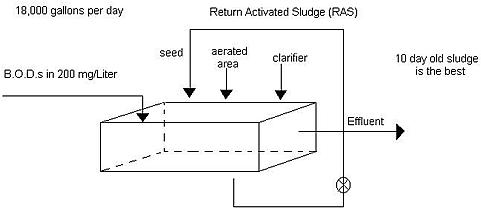
The concentration of the activated sludge solids and the condition of those biological solids determines the effectiveness
of an activated sludge process. Too few or too many organisms in a system will cause operational control problems, reducing treatment plant efficiency and causing an added load on the receiving waters. Sludge age is defined as the average time in days the suspended solids remain in the entire system.
To successfully maintain a viable biological population and to maintain the proper concentration of solids, the system requires continuous observation and monitoring by the operator. Sludge age is one of the methods or tools available to the operator to help maintain the desired amount of solids in the aeration tank. Sludge age is a relatively easy control parameter to monitor because the suspended solids in the aeration tank are easy to measure. Sludge age considers the :
- Solids entering the aerator; measured as primary effluent suspended solids in mg/L.
- Solids or organisms available to degrade the wastes; measured as Mixed Liquor Suspended Solids, mg/L.
The common range for sludge age for a conventional activated sludge plant is between 3 and 15 days. For extended aeration activated sludge plants the range is between about 15 and 30 days. Generally during the winter months, higher sludge ages
are required to maintain a sufficient biological mass. In the summer time, biological activity increases and lower sludge ages normally produce a higher quality effluent. Thus, the sludge age should be adjusted at least twice a year to
accommodate seasonal variations. The operator must realize, however, that the optimum sludge age may not fall in the common ranges given here. This is due to the fact that the waste characteristics, process design, flexibility in operation, and
process control equipment are different for all facilities. The operator, by trial and error, can find the optimum sludge
age for that particular plant and specific conditions.
A low sludge age tends to produce a light, fluffy, buoyant type of sludge particle commonly referred to as straggler floc, which settles slowly in a final clarifier. This will be witnessed in a clarifier when these buoyant, fluffy sludge particles are being pulled over the weirs even though the effluent may be crystal clear.
A high sludge age or too many solids in the system tends to produce a darker, more granular type of sludge particle,
commonly called pin floc, which settles too fast in a final clarifier. Pin floc is observed as many fine tiny floc
particles coming over the final clarifier weirs leaving a very turbid effluent.
Mean Cell Residence Time ( MCRT )...
Another operational approach for solids control, like the sludge age, is the mean cell residence time (MCRT) or Solids Retention Time (SRT). This parameter is a refinement of the sludge age and takes into consideration the total solids inventory in the secondary or biological system. Again, the desired MCRT for a given plant must be found experimentally
just like the sludge age.
Food / Mass Ratio...
The Food/Mass or the Food/Microorganism ratio commonly referred to as F/M is based upon the ratio of food fed to the microorganisms each day to the mass of microorganisms held under aeration. It is a simple calculation, using the results
from the influent BOD test to the aerator and the mixed liquor suspended solids test. Using the COD test may be preferred because the results are available sooner than the five day BOD. Common ranges for F/M for a conventional activated sludge plant are from 0.15 to 0.5. These values refer to calculations based on the 5 day BOD test. The optimum F/M varies from
plant to plant and can be determined by trial and error. Generally, low F/M ratios should be carried during the colder
months.
The mixed liquor volatile suspended solids (MLVSS) may be a more accurate estimate of the mass of microorganisms than MLSS.
Control Methods...
Constant Mixed Liquor Suspended Solids...
One of the easiest control procedures for activated sludge systems is the Constant Mixed Liquor Suspended Solids method.
In this method, the operator selects a certain MLSS concentration or range of mix liquor concentrations that produce the
best effluent and the highest removal efficiencies. This specific value or range must be determined experimentally. When
the operator finds the optimum MLSS concentration for each plant, he attempts to maintain this value by adjusting the
sludge wasting rate.
One rule of thumb for activated sludge systems is that for every pound of BOD removed in the secondary system a half a
pound of new solids is generated through reproduction of the organisms and addition of new organisms from the influent wastes. So, the operator tries to waste the proper amount of solids to keep his selected optimum mix liquor concentration constant.
If the MLSS concentration is above the desired concentration, wasting of the excess solids will have to be started or increased.
If the MLSS concentration is below the desired concentration level, wasting should be decreased or stopped.
Operators should keep in mind that in most cases it is better to waste continuously over 24 hrs/day, seven days a week than to waste intermittently. Drastic changes in sludge wasting rates are undesirable. Increases or decreases in wasting should
be made gradually, i.e., 20 - 25 percent per day.
Return Activated Sludge Control...
To properly operate the activated sludge process, a good settling mixed liquor must be achieved and maintained. The MLSS
are settled in a clarifier and then returned to the aeration tank as the Return Activated Sludge (RAS). The RAS makes it
possible for the microorganisms to be in the treatment system longer than the flowing wastewater. For conventional
activated sludge operations, the RAS flow is generally about 20 to 40 percent of the incoming wastewater flow. Changes
in the activated sludge quality will require different RAS flow rates due to settling characteristics of the sludge.
There are two basic approaches that can be used to control the RAS flow rate. These approaches are based on the following :
- Controlling the RAS flow rate independently from the influent flow.
- Controlling the RAS flow rate as a constant percentage of the influent flow.
Constant RAS Flow Rate Control...
Settling the RAS at a constant flow rate that is independent of the aeration tank influent wastewater flow rate results in
a continuously varying MLSS concentration that will be at a minimum during peak influent flows and a maximum during minimum influent flows. This occurs because the MLSS are flowing into the clarifier at a lower rate during peak flow when being removed at a constant rate. Similarly, at minimum influent flow rates, the MLSS are being returned to the aeration tank at
a higher rate than are flowing into the clarifier. The aeration tank and the secondary clarifier must be looked at as a system where the MLSS are stored in the aeration tank during minimum wastewater flow and then transferred to the clarifier
as the wastewater flows initially increase. In essence, the clarifier acts as a storage reservoir for the MLSS, and the
clarifier has a constantly changing depth of sludge blanket as the MLSS moves from the aeration tank to the clarifier and
vice versa. The advantage of using this approach is simplicity, because it minimizes the amount of effort for control. It
is also especially advantageous for small plants because of limited flexibility.
Constant Percentage RAS Flow Rate Control...
The second approach to controlling RAS flow rate requires a programmed method for maintaining a constant percentage of the aeration tank influent wastewater flow rate. The program may consist of an automatic flow measurement device, a programmed system, or frequent manual adjustments. The programmed method is designed to keep the MLSS more constant through high and
low flow periods.
Comparison of Both RAS Control Approaches...
The advantages of the constant RAS flow approach are as follows :
- Simplicity.
- Maximum solids loading on the clarifier occurs at the initial start of peak flow periods.
- Requires less operational time.
The advantages of the constant percentage RAS flow are the following :
- Variations in the MLSS concentration are reduced and the F/M varies less.
- The MLSS will remain in the clarifier for shorter time periods, which may reduce the possibility of denitrification in
the clarifier.
A disadvantage of using the constant flow approach is that the F/M is constantly changing. The range of F/M fluctuation
due to the effect of short term variation in the MLSS (because of hydraulic loading) is generally small enough so that no significant problems arise due to using this approach. The most significant disadvantage of the second approach is that
the clarifier is subjected to maximum solids loading when the clarifier contains the maximum amount of sludge. This may result in solids washout with the effluent. In general, it appears that most activated sludge operations perform well and require less attention when the constant RAS flow rate approach is used. Activated sludge plants with flows of 10 mgd or
less are often subject to large hydraulic surges, and performance of these plants will benefit the most from the use of
this approach.
Operational Guidelines...
Though these operating parameters are widely used, the details of the operating procedure will vary at different activated sludge plants, depending on the type of facilities available, strength and character of the wastewater, temperatures,
requirements of the receiving waters, etc. The best operating procedure for each plant must be determined by experience.
Some guidelines that may be applied to a conventional activated sludge plant are :
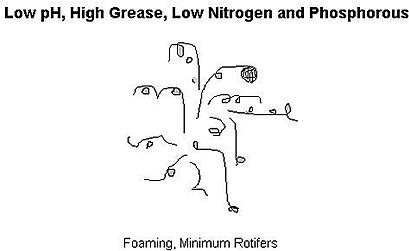

- There must be sufficient aeration to maintain a dissolved oxygen concentration of at least two mg/L at all times
throughout the aeration tanks.
- Dissolved oxygen should be present at all times in the treated wastewater in the final settling tanks.
- Activated sludge must be returned continuously from the final settling tanks to the aeration tanks.
- Optimum rate of returning activated sludge will vary with each installation and with different load factors. In general,
it will range from 20 to 40 percent of the influent wastewater flow for diffused air and 10 to 40 percent for mechanical aeration units.
- The optimum mix liquor suspended solids concentration in the aeration tanks may vary considerably, but usually is in the range of 600 to 3,000 mg/L. Optimum MLSS concentrations should be determined experimentally for each plant.
- A sludge volume index of about 100 and a sludge age of three to fifteen days are normal for most plants. When the optimum
sludge volume index is established for a plant, it should be maintained within a reasonably narrow range. A substantial increase in SVI is a warning of trouble ahead.
- The suspended solids content in the aeration tanks may partially be controlled by the amount of sludge returned to them. All sludge in excess of that needed in the aeration tanks must be removed from the system. It should be removed in small amounts continuously or at frequent intervals rather than in large amounts at any one time. Sludge held too long in the
final settling tank will become septic, lose its activity and deplete the necessary dissolved oxygen content in the the tank.
- Septic conditions in the primary sedimentation tanks will adversely affect the functioning of the activated sludge process. Prechlorination or pre-aeration may be used to forestall septic conditions in the wastewater entering the aeration tanks. Septic primaries have been shown to cause filamentous bulking.
- Periodic or sudden organic overloads that may result from large amounts of sludge digester overflow to the primary tanks
or from doses of industrial wastes having an excessive BOD or containing toxic chemicals will usually cause operating difficulties. Whenever possible, overloading should be minimized by controlling the discharge or by pretreatment of such deleterious wastes.
The basic indicator of normal plant operation is the quality of the plant effluent. Failure of plant efficiency may be due
to either of the two most common problems encountered in the operation of an activated sludge plant, namely, rising sludge and bulking sludge.
Final Clarification...
For an activated sludge process to achieve optimum plant efficiency the final clarification unit must effectively separate the biological solids from the mix liquor. If these solids are not separated properly and removed from the clarifier in a relatively short period of time, operating problems will result, causing an increased load on the receiving waters and a decline in plant efficiency. The most important function of the final clarifier is to maintain the wastewater quality produced by the preceding processes.
Design Considerations...
Final clarifiers should be designed with rapid sludge withdrawal systems to inhibit the tendency of the sludge to become anaerobic if not removed quickly.
Weirs should be of the saw-tooth type to allow for better weir overflow and flow distribution. Weirs should be level
and free from scum and algae to prevent short-circuiting within rhe clarifier. The tanks should be sufficiently baffled
to reduce velocities and to disperse the flow evenly to reduce short-circuiting.
Short-circuiting will tend to increase the solids losses over the clarifier weirs. Also, final clarifiers should include
some type of surface skimming device to remove floating solids and scum. Final clarifiers should be designed with a
hydraulic detention time from 2 - 3 hours.
Operational Problems with Final Clarifiers...
The operator must keep in mind that many operating problems in the final clarifier can be associated with operating problems in the preceding processes, i.e. mainly the aeration system.
Floating Solids...
This is commonly referred to as "clumping", "ashing" or "rising sludge". Floating solids are usually due to a high sludge
age (too many solids in system) or too long of a solids detention time in the final clarifier.
Remedies :
- Decrease solids inventory (increase wasting rate).
- Remove solids from final clarifier quicker.
- Check for any dead spots in clarifier where solids are not being collected and removed.
A heavy accumulation of solids on the surface of a clarifier may be alleviated by spraying the surface with a high pressure hose to knock the solids down.
Solids Losses Over Effluent Weirs...
Excessive solids losses in the final clarifier can be the result of hydraulic overload or due to the type and
characteristics of the biological solids present.
( 1 ) Straggler Floc is indicative of a young sludge which tends to settle slowly. This type of floc consists of light, fluffy, buoyant particles. This situation can be intensified by short-circuiting and hydraulic overloads.
Remedies :
- Increase solids inventory by decreasing the wasting rate to produce an older sludge which tends to settle faster.
- Check clarifier for short-circuiting.
- Calculate detention time and check for hydraulic overloading.
( 2 ) Pin Floc is indicative of an older sludge which tends to settle too fast, leaving many fine suspended particles in the supernatant and a turbid effluent. The sludge particles are usually darker, heavier and more granular in appearance.
Remedies :
- Increase sludge wasting rate to decrease solids inventory.
- Check for short-circuiting and hydraulic overload.
Fouling of Weirs...
An accumulation of solids and/or algae on the weir surfaces can cause short-circuiting within the tank, creating excessive velocity currents that pull solids over the effluent weirs.
Remedies :
- A thorough scrubbing of weir surfaces to remove solids build-up.
- Strong chlorine solutions applied to the weirs is also effective.
Plugging of Withdrawal Ports...
Is usually caused by too high of a solids concentration in the return sludge.
Remedy :
- Withdraw sludge faster and/or more frequently.
Rising Sludge...
Unlike bulking, the problem of rising sludge is only seen in the final settling tank and has definite operational causes
and it can be corrected through an understanding of the system and defined management practices.
The biological oxidation of a wastewater has been described as a two-phase reaction where organic carbon oxidation occurs first and is usually followed by the biological oxidation of ammonia or nitrification. Domestic wastewaters, as already noted, besides having organic, carbon containing compounds always contain ammonia. Generally, prolonged aeration or organic underloading of a biological wastewater treatment plant can result in a condition where oxidation of most of the organic matter occurs (that is, carbon is converted to carbon dioxide) and nitrification follows. This process of nitrification involves the conversion of ammonia, nitrogen and organic nitrogen to nitrate nitrogen.
The nitrates that are formed in the aeration tank then flow into the final settling tank where quiescent settling and solids
removal will take place. If the dissolved oxygen levels are sufficiently low in the settling tank and there is some organic
matter available, denitrificaton will take place.
Rising sludge is caused by denitrification in which nitrites and nitrates in the wastewater are reduced to nitrogen gas.
Denitrification occurs in the sludge layer in the secondary clarifier when conditions become anaerobic or nearly anaerobic. As the nitrogen gas accumulates, the sludge mass becomes buoyant and rises or floats to the surface. Rising sludge can
easily be differentiated from a bulking sludge by noting the presence of small gas bubbles attached to the floating solids and by microscopic examination. This problem can be overcome by increasing the removal rate of the sludge from
sludge-collecting mechanism, by regulation of the flows (loading) and monitoring of the dissolved oxygen levels in the final settling tank.
Filamentous Bulking...
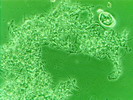
Filaments... |
Generally, non-flocculent or non-settling microbial growth is the result of either suppressing the normal wastewater treatment bacteria or promoting conditions favorable to filamentous microorganisms, such as fungi or actinomycetes which cannot be settled readily. The presence of filamentous microorganisms to the point where they interfere with settling is called bulking. This condition may be seen in the aeration tanks of activated sludge processes and is sometimes accompanied by frothing. The solids do not settle in the final settling tank and a homogeneous blanket of solids will pour out over the effluent weirs, especially during diurnal peak flow variations. Filamentous bulking can be recognized through a microscopic examination of the mix liquor and observing the presence of these microorganisms in the flocculent material that does not settle. Under filamentous bulking conditions the presence of filaments is obvious and the filaments can be seen preventing more normal looking flocs from coming together.
The conditions associated with filamentous bulking are not always well understood, but have been associated with high
organic loadings, pH changes, low pH wastewaters, inputs of industrial wastes, low dissolved oxygen levels, seasonal variations, septic primaries, and an improper balance between carbon, nitrogen and phosphorous in the waste. The problem of bulking is not easy to deal with since its causes cannot always be identified. However, a careful review of the operating records with respect to pH, loading, and aeration tank DO, MLSS, etc. is always useful in attempting to develop
relationships between poor operating conditions and bulking. Careful records and trending as well as a close control over operating conditions and a knowledge of inputs into the wastewater system is useful.
When bulking of activated sludge is caused by overloading, prechlorination to reduce the load on the aeration process has been tried with some success. Prechlorination of the primary tank influent to produce a residual of about 0.1 mg/L in the primary tank effluent is used. Prechlorination of the primary tank influent is particularly useful in controlling septicity. Chlorination of the return activated sludge can control filamentous bulking. The point of application should be where the return sludge will be in contact with the chlorine solution for about one minute before the sludge is mixed with the aerator influent. The chlorine dose is varied according to the variations in the sludge volume index and may be estimated as
follows :
SVI x F x W x 8.34 x 106 = Pounds of chlorine per day
Where: SVI = Sludge Volume Index, F = Return sludge rate in million gallons per day and W = Suspended solids in return
sludge in mg/L.
Chlorine dosages can better be determined by trial and error. In general, chlorination of a bulking sludge will reduce the sludge volume index, thus the dose is reduced daily until bulking is corrected. In some plants intermittent chlorination
will maintain a low sludge volume index, and in others continuous chlorination of the return sludge has proven more satisfactory. Generally, when chlorination of the return sludge is started, the turbidity of the plant effluent will increase, but after a few days of operation the turbidity will again decrease to that of normal conditions.
Extensive wasting of the biological sludge to reduce the filamentous organisms also has proven to be somewhat effective in alternating a bulking situation.
The operator must realize that these measures are only temporary steps to alleviate bulking and that the problem may
reappear if the cause is not identified and corrected.
Organisms in the Activated Sludge Process...
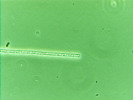
Beggiatoa... |
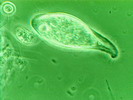
Ciliate... |
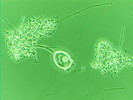
Floc and Stalked... |
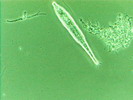
Rotifer... |
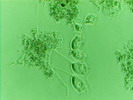
Stalked Ciliate... |
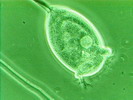
Stalked Ciliate... |
















